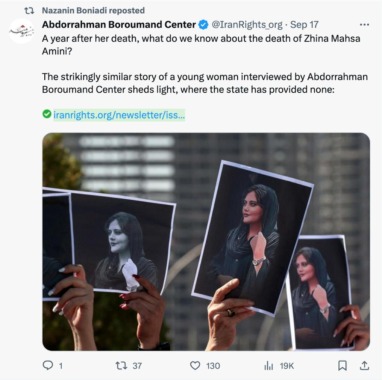
“The Symbolic Feminism Expressed Through Gestures by Iranian Women”

## Gestural Feminism: Art and Resistance in Iran
### Introduction
Resistance in Iran is nothing new, but in recent years, Iranian women have elevated their struggle against systemic oppression to impressive heights through what can be called **Gestural Feminism**. Their bodies have become art, their gestures a language of defiance, forming a movement that intertwines protest with performance art. One of the key symbols of this movement emerged in the actions of **Ahoo (Mahla) Daryaei**, a doctoral student at Azad University in Tehran, whose protest against the compulsory hijab ignited nationwide and international dialogue around the intersection of art, feminism, and freedom in Iran.
In this article, we explore how Iranian women are continuously turning the everyday movements of their bodies into powerful statements, using **nonverbal acts** to challenge the regime’s authority. We’ll delve into how this activism has sparked creative representations in art and become an enduring part of Iran’s push for self-expression and bodily autonomy.
### Daryaei’s Bold Protest Against the Hijab
Ahoo (Mahla) Daryaei’s protest was both symbolic and shocking. She stripped down to her underwear in front of her peers at **Tehran’s Azad University**, reacting against the university’s **Basij paramilitary group** for allegedly harassing her over her failure to fully adhere to Iran’s Islamic dress code. The Basij faction is notoriously aligned with the Islamic Revolutionary Guards, enforcing the country’s strict mandates concerning women’s attire. What turned Daryaei’s bold act into a national talking point was its dissemination over social media. Images of her were shared worldwide under the hashtag **#GirlofScienceAndResearch**, turning her into a potent symbol of resistance for women’s rights in Iran.
The incident not only drew attention to the violent enforcement of mandatory hijab laws but also to the lengths the Iranian regime would go in punishing dissent. Daryaei was arrested and reportedly detained in a psychiatric hospital, a common tactic used by the regime to dismiss political protestors as “mentally unstable.” However, much like past acts of courage by dissenters in Iran, Daryaei’s protest went far beyond a single moment of disruption—it became a cultural flashpoint, inspiring widespread artistic reactions.
### The Role of Art in Resistance
In the wake of Daryaei’s protest, social media exploded with artistic portrayals of her act. Artists depicted her standing defiantly before **tanks**, or towering over **Iranian morality police** in surreal and symbolic scenarios. These images not only challenged the regime’s narrative but also evoked historical parallels, such as the iconic **Tank Man** of China’s 1989 Tiananmen Square protests. The comparison underscores the universality of Daryaei’s message—individual defiance radiates far beyond borders.
This modern wave of Iranian feminist protest finds its antecedents in similarly bold gestures from women like **Vida Movahed**, who became an icon in 2017 for waving a white headscarf on a stick while standing on a utility box on Tehran’s **Revolution Street**. Her actions echoed on the streets, forming a movement called the **”Girls of Revolution Street”** where women similarly cast off their mandatory hijabs, symbolizing resistance in subtle but powerful ways. Daryaei’s protest is, in many ways, an extension of this coded yet uncompromising form of rebellion that Iranian women have long employed.
### Gestural Feminism As Art
Gestural Feminism can best be described as the use of the body itself in acts of political resistance. It is a distinctly Iranian form of protest that elevates nonverbal actions to the realm of performance art. Instead of merely waving slogans or chanting, the very presence of the female body in public spaces—often in contradiction to state-sanctioned norms—serves as a form of rebellion.
Such moments of defiance, be they stripping in public or walking hijab-less through crowded streets, carry weight in their silence—they communicate without a single spoken word. Artists, too, have been inspired by the possibilities of expression through gesture. For example, in 2011, a group of women dressed in red stood daily in Tehran’s Ferdowsi Square, silently honoring a woman who had stood there—also in red—awaiting her lost love before the Islamic Revolution. Their presence was a spectacle of both remembrance and resistance, challenging the oppressive forces around them simply by occupying space.
Further examples include filmmaker and dancer **Tanin Torabi**, who in 2017 performed a **slow-motion dance** through Tehran’s **Tajrish Bazaar**, silently subverting the public’s expectations of appropriate female behavior in conservative settings. The subtle, quiet nature of Torabi’s performance delivered a strong feminist message: in the context of an authoritarian, religious regime, even ordinary movements can become acts of rebellion.
### The Ongoing Struggle for Aut